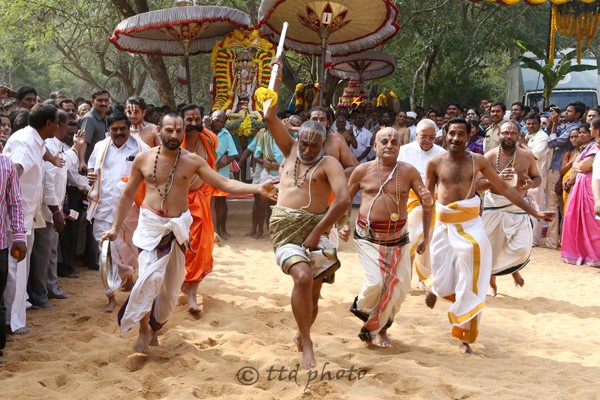Description

Disclaimer: Copyright infringement not intended.
Context
Indian National Trust for Art and Cultural Heritage (INTACH) is making efforts to secure UNESCO recognition for the annual 'Paruveta' festival.
Details
About Paruveta Utsavam
- Location: The fest, also known as the ‘mock hunting festival’, takes place at the Sri Narasimha Swamy temple in Ahobilam, which is under the governance of the 600-year-old Ahobila Mutt.
- Promotion of Srivaishnavism: The temple, through the 'Guru Parampara', has played a significant role in promoting Srivaishnavism among tribal communities. This is evident from the Sanskrit drama Vasanthika Parinayam authored by the Mutt's 7th Jeeyar.
- Symbolism of Communal Harmony: Paruveta Utsavam symbolizes communal harmony. During the festival, the deity from the temple's sanctum sanctorum is taken to the 32 Chenchu tribal hamlets around Ahobilam for 40 days, known as a Mandala.
- Ceremonial Procession: The spiritual journey begins with tribal individuals aiming their bows and shooting two arrows at the palanquin carrying the deity. This act symbolizes reverence and their protective watch over the deity.
- Sankranti Festival: The festival coincides with the Sankranti festival, which is celebrated on the day the deity reaches each Chenchu hamlet.
- Duration: While Paruveta is commonly observed in many temples during Vijayadasami or Sankranti, it is unique to Ahobilam as it is conducted for a full Mandala, lasting forty days.
- Narasimha Deeksha: Chenchus participating in the festival take 'Narasimha Deeksha' by wearing yellow robes and 'Tulasi Mala' (a necklace made of basil beads). They observe celibacy during this period.
- Spiritual Significance: The Pancharatra Agama, which is a doctrine of temple worship, refers to Paruveta as 'Mrugayotsava' and provides guidelines for its conduct, emphasizing its significance in temple worship.
Folklore:
- According to folklore, Lord Vishnu, in his Narasimha incarnation, wedded Maha Lakshmi, who was incarnated as a tribal girl named Chenchulakshmi in Ahobilam. The Chenchu tribes honored Narasimha as their brother-in-law and invited him home for Makara Sankranti.
- The Chenchus are a Dravidian tribe designated as a Scheduled Tribe in several Indian states. Their traditional way of life is based on hunting and gathering, and they speak the Chenchu language, a Dravidian language.
- The relationship between Chenchus and non-tribal people has been largely symbiotic, with some Chenchus specializing in collecting forest products for sale. Despite government efforts to encourage agriculture among them, many Chenchus remain dependent on hunting and gathering.

About Chenchus
- The Chenchus are a Dravidian tribe indigenous to the Indian states of Andhra Pradesh, Telangana, Karnataka, and Odisha.
- They hold the status of a Scheduled Tribe, recognized and protected by the government due to their distinct cultural identity and historical marginalization.
Cultural and Linguistic Background:
- Dravidian Tribe: The Chenchus belong to the Dravidian ethnic group, which is one of the major linguistic and cultural groups in South India. Their language, known as Chenchu, is a member of the Dravidian language family, indicating their deep-rooted connection to the region.
- Traditional Lifestyle: Historically, the Chenchus' traditional way of life has been centered around hunting and gathering. They have relied on the forests for sustenance, collecting forest products such as fruits, nuts, roots, and medicinal plants.
- Forest Dependency: As one of the Primitive Tribal Groups, the Chenchus are heavily dependent on forest resources for their livelihood. They do not engage in agriculture but instead rely on the bounty of the forests for food, shelter, and other essential needs.
Socioeconomic Relations:
- Symbiotic Relationships: The relationship between the Chenchus and non-tribal people has often been symbiotic. Some Chenchus specialize in collecting forest products for sale to non-tribal communities, contributing to the local economy.
- Land Use: Non-tribal people living among the Chenchus may rent land from them for cultivation, paying a portion of the harvest as rent. Additionally, some individuals from outside communities have settled among the Chenchus, learning agricultural practices from them.
- Government Interventions: Government efforts to encourage the Chenchus to take up agriculture have been met with limited success. Despite initiatives aimed at promoting agricultural activities among the tribe, many Chenchus have remained hesitant to transition away from their traditional forest-based livelihoods.
Geographic Context:
- Nallamala Forest: Many Chenchus reside in the sparse and deciduous Nallamala forest, which spans parts of Telangana and Andhra Pradesh. This forest serves as their habitat and primary source of sustenance.
- Interaction with Nomadic Groups: The Chenchus share their forest habitat with nomadic groups such as the Banjara herders, who graze their cattle in the region. Despite their different lifestyles, these groups coexist within the forest ecosystem.
About INTACH
- The Indian National Trust for Art and Cultural Heritage (INTACH) is a prominent non-profit organization dedicated to the conservation and preservation of India's rich cultural and natural heritage.
History:
- Foundation: INTACH was founded in 1984 in New Delhi with the objective of stimulating heritage awareness and conservation efforts across India.
- Vision: The organization aimed to create a membership-based platform to spearhead heritage conservation initiatives.
Membership and Chapters:
- Membership: INTACH is the largest membership organization in India dedicated to heritage conservation, with chapters in 215 Indian cities.
- International Presence: It also has chapters in Belgium and the United Kingdom, extending its conservation efforts beyond India's borders.
Governance:
- Governing Council: The initial Governing Council of INTACH included prominent figures such as Rajiv Gandhi, Pupul Jayakar, L. K. Jha, and others.
- MoU with AusHeritage: In 2007, INTACH signed a memorandum of understanding with AusHeritage, Australia's heritage network, to collaborate on regional initiatives.
Activities:
- Conservation and Restoration: INTACH undertakes the restoration and conservation of monuments, buildings, and heritage sites, including those outside the purview of government agencies.
- Advocacy and Awareness: The organization advocates for heritage conservation through public awareness campaigns, heritage walks, and educational initiatives such as heritage clubs in schools.
- Protests and Activism: INTACH has been involved in protests against the destruction of heritage structures and has advocated for the preservation of culturally significant sites.
- Memoranda of Understanding (MoU): INTACH has signed MoUs with various governments and organizations for the restoration and conservation of heritage monuments and sites. For example, in 2007, it signed an MoU with the government of Goa for the restoration of 51 heritage monuments.

Projects:
- Heritage Villages: INTACH has developed heritage villages like Raghurajpur in Odisha and Padmanabhpur in Ganjam district, Odisha, into rural tourist destinations.
- Collaborations: The organization collaborates with government agencies, corporate houses, and international organizations to undertake conservation and restoration projects.
Awards and Recognition:
- Anirudh Bhargava – INTACH Environmental Award: Instituted in memory of Anirudh Bhargava, this award recognizes contributions to environmental conservation.
- INTACH Award for Best Practices in Heritage Conservation: Recognizes exemplary efforts in heritage conservation.
- INTACH-STATE Heritage Tourism Award: Acknowledges innovative work in heritage tourism.
Funding and Support:
- Funding Sources: INTACH raises funds through international chapters, corporate sponsorships, and government grants to support its conservation projects.
- INTACH UK Trust: The INTACH UK Trust, established in 1987, supports heritage conservation in India through funding and scholarships for heritage research.
- Government Support: INTACH collaborates with central and state governments, as well as international agencies and corporate entities, to advance its conservation goals.
|
PRACTICE QUESTION
Q. INTACH continues to play a pivotal role in heritage conservation, advocating for the protection of India's diverse cultural and natural heritage for future generations. Comment. (250 words)
|
















